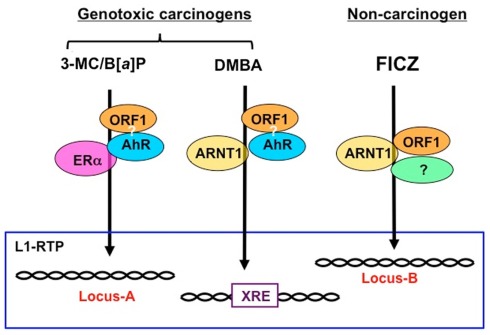Figure 1.
Schematic modes of L1-RTP triggered by environmental compounds. Given that ORF1, which associates with retroelements, is recruited to the chromatin, regions of L1-RTP are likely determined by the binding partners of ORF1. As shown in Table 1, the induction of L1-RTP by environmental compounds depended on different sets of bHLH/PAS proteins. The induction of L1-RTP by DMBA depended on AhR and ARNT1, whereas that by 3-MC and B[a]P required AhR. Interestingly, L1-RTP by 3-MC and B[a]P did not require ARNT1, but depended on ERα. By contrast, FICZ-induced L1-RTP depending on ARNT1, whereas it did not require AhR. It is plausible that the regions where these compounds insert L1 are different: DMBA induces L1-RTP in the vicinity of XRE, whereas 3-MC and B[a]P induce L1-RTP in the region determined by AhR and ERα. The locus of L1-RTP by FICZ would differ from those determined by these genotoxic carcinogens. To prove this, it is necessary to identify the association of ORF1 and AhR and genome regions where L1 is inserted in response to each environmental compound.

